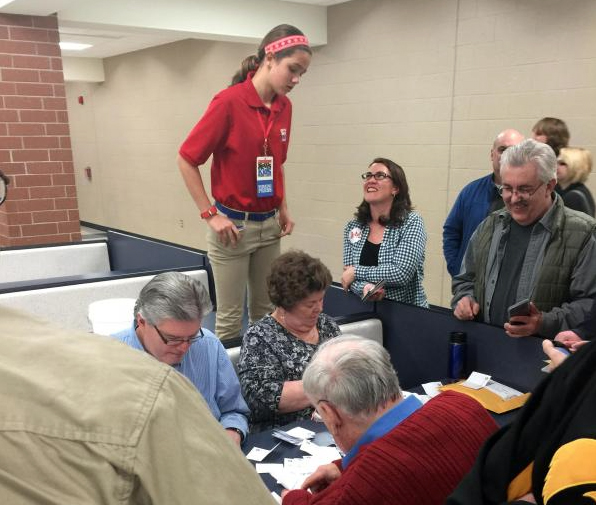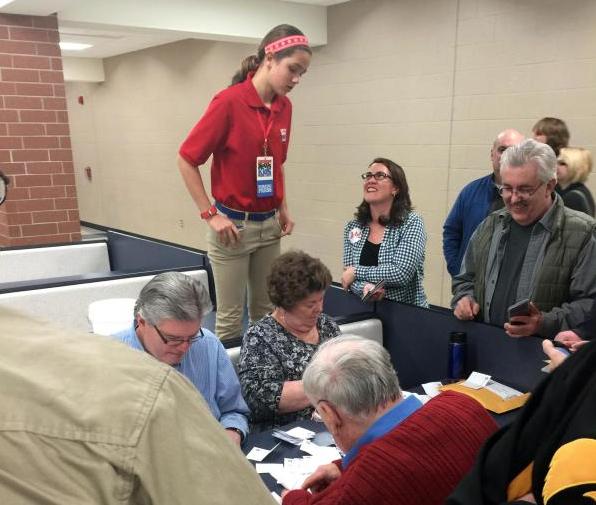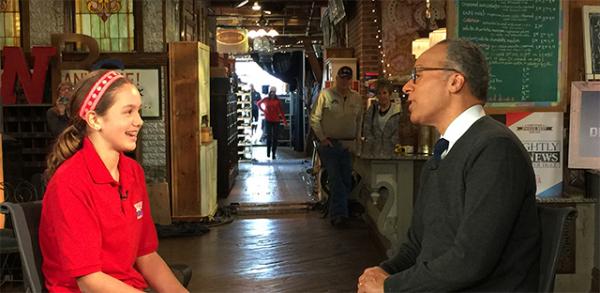KID REPORTERS’ NOTEBOOK
A Kid at a Caucus


Lilian watches votes being counted at a Republican caucus at Urbandale High School in Iowa.
On January 31, I traveled to Iowa from Milwaukee, Wisconsin, to answer the question: What is a caucus? Along the way, I talked to voters, presidential candidates, and reporters to learn about the Iowa caucuses.What are caucuses? Many people want to be president of the United States. So every four years, there’s a first round of voting (primaries and caucuses) in each state. That process leads to the selection of the Democratic and Republican nominees who will compete for the presidency in November.
Most states have primaries that allow voters to go to polling stations throughout the day and evening. But Iowa and a few other states have caucuses. Voters go to a polling place at a specific hour, and listen to neighbors explain why they think a certain candidate would be a good president. It’s harder for political campaigns to get people out to caucuses because it requires getting them in the same place at the same time.

Lilian talks with NBC Nightly News anchor Lester Holt.
MY 24 HOURS IN DES MOINES
Iowa traditionally has the first caucuses in the country. This year, they were held on February 1. Hillary Clinton hosted her final rally the night before. I arrived early, at 6:30 p.m., to get my press credentials and do some interviews. First, I had to go through a security screening conducted by the Secret Service. Everyone who entered the building had to do the same.
The rally was held at Abraham Lincoln High School in Des Moines, the state capital. The gymnasium was packed. Clinton’s supporters chanted, “We believe that she will win!” over and over, as photographers attached cameras to tripods, and journalists, like me, walked around to conduct interviews.
At 8 p.m., my editor and I pushed our way into the enormous crowd to watch Clinton walk to the podium. Shoulder to shoulder, everyone waited another hour to see the Democratic candidate—a former First Lady, New York Senator, and Secretary of State.
When Secretary Clinton came out from behind the curtain, there was an ear-splitting cheer from the crowd. Everyone in the stands rose to their feet to get a glimpse of her as she walked past hundreds of people. On the podium, she joined her husband, Bill, and daughter, Chelsea, who had already spoken. She hugged them and began to talk, much to the delight of the crowd. During her 40-minute speech, Clinton discussed raising the minimum wage, fighting for working-class families, and the need for more early childhood education. The crowd roared in approval.
ON THE SET OF TODAY
On caucus day, I woke up at 4:30 a.m. to watch NBC’s Today show behind the scenes at the West End Architectural Salvage, a furniture shop that had been converted into a TV set for the occasion. I couldn’t believe how many cameras were needed to produce the show. During the taping, I briefly stood next to Florida Senator Marco Rubio, a Republican candidate who was interviewed that morning and came in third that evening.
That afternoon, I interviewed Lester Holt, the anchor of NBC Nightly News, about covering presidential campaigns. A producer clipped a microphone to my shirt, and two huge TV cameras recorded the whole thing.
CASTING VOTES
The night of the Iowa caucuses was probably one of the most exciting of my life. My editor and I arrived at Urbandale High School, a caucus site near Des Moines, at 6:15 p.m. After touring the school and speaking with some voters, we decided to view the Republican caucus in the school’s community room.
The caucuses began at 7 p.m. While Democrats vote with their actual bodies, lining up in rows of 10 to show support for their candidate, Republicans use secret ballots. During the Republican caucus, there were two things that I found really interesting. The first was listening to people speak about their favorite candidates. The second was watching volunteers count the ballots by hand. Five or six people would separate the ballots according to names. Each pile was then counted at least twice to make sure that the tally was correct.
It was really suspenseful, but fun to guess who would win. At the Urbandale Republican caucus, Texas Senator Ted Cruz came in first. On the Democratic side, Clinton got slightly more votes than Vermont Senator Bernie Sanders. Cruz ended up winning the entire state. For the Democrats, the statewide race was so close that it couldn’t be called until several hours later. Clinton was declared the winner by a narrow margin.
The people who caucused in Iowa seemed very committed to being part of the political process. Some families I saw even showed up with young kids in pajamas!
Covering the caucuses made me realize how lucky we are as Americans to pick our leaders. I saw visitors from other countries who looked with admiration on the freedom we have. As Holt told me, when you cover a presidential campaign, you realize how important it is to inform voters about the candidates and the issues.
See Lilian’s interview about the presidential campaign with NBC Nightly News anchor Lester Holt.
